Austrian stage and film actor Heinrich Peer (1867–1927) belonged to the pioneers of the German cinema and appeared in more than hundred films between 1911 and 1927. The tall, thin actor with the distinctive, almost sinister face often played supporting parts in adventure and detective films, but also played in melodramas and historical films.

German postcard by NPG. no. K 116. Photo: Alex Binder, Berlin.

German postcard by NPG. no. 547. Photo: Alex Binder, Berlin.
Heinrich Friedrich Peer was born in Vienna, Austro-Hungarian Empire, in 1867. He began his stage career at the Raimundtheater in Vienna and from 1892 on, he played in a theatre in Esseg (now Osijek, Croatia). After stopovers in Innsbruck and Pressburg (now Bratislava, Slovakia), he made his Berlin debut in 1902 at the Intimen Theater.
Heinrich Peer often appeared in operettas, especially at the Theater des Westens. There he played leading roles in Oscar Straus' Ein Walzertraum (A Waltz Dream) and Franz Lehár’s Die lustige Witwe (The Merry Widow).
Already in 1911, he made his film debut. That year he played in the short silent melodrama Nachtfalter/Moth (Urban Gad, 1911), which was only the second German film with Danish diva Asta Nielsen. The shooting took place in Bioscope-Atelier Chausseestrasse in Berlin, a studio with glass walls and artificial lighting with electric light. The silent film is now considered lost, like many other films of this period.
Peer also played in the silent short Mutters Todestag/Mother’s death (Adolf Gärtner, 1911) for the Messter studio. Peer then appeared for the Vitascope studio in the very popular detective comedy Wo ist Coletti?/Where is Coletti? (Max Mack, 1913), featuring Hans Junkermann, and in the comedy Die blaue Maus/The Blue Mouse (Max Mack, 1913), featuring Fritzi Lustig.
Peer also played a count in Der Geheimsekretär/The private secretary (Joe May, 1915), a part in another popular crime series about detective Joe Deeb played by Max Landa. He next played the best friend of the title figure in the comedy Hampels Abenteuer/Hampel's Adventure (Richard Oswald, 1915) with Georg Baselt as Hampel and a supporting part in Schlemihl (Richard Oswald, 1915) starring Rudolph Schildkraut and his son Joseph Schildkraut.
Peer also appeared in dramas such as Die Ruf der Liebe/The call of love (Rudolf Biebrach, 1916) with Henny Porten, and Die Liebe der Hetty Raymond/The love of Hetty Raymond (Joe May, 1917), featuring Mia May.
In the late 1910s, Peer now and then played leading roles, such as in Im stillen Ozean/In the Silent Ocean (Danny Kaden, 1917). He played the famous sleuth Harry Reep in Eine Nacht in der Stahlkammer/A night at the vault (Felix Basch, 1917) with Harry Liedtke as a shameless bank director, and Leopoldine Konstantin as his accomplice.
In 1918, he played an English officer in Ernst Lubitsch´s silent drama Carmen (Ernst Lubitsch, 1918), which established the stardom of actress Pola Negri. Carmen was based on the novella by Prosper Mérimée. Peer played another detective, Council Anheim, in a fairly short-lived detective series, including Der grüne Vampyr/The green Vampire (William Kahn, 1918). This crime film with horror elements was one of the first films that brought vampirism on the screen.
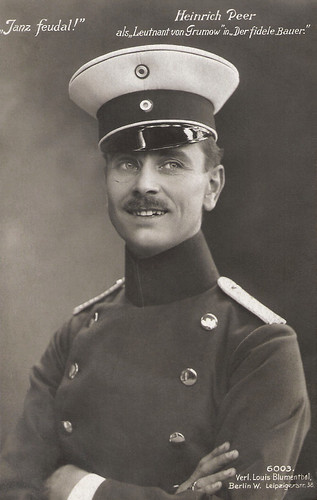
German postcard by Verlag Louis Blumenthal, Berlin, no. 6003. Caption: `Janz feudal! Heinrich Peer als Leutnant von Grumow in Der fidele Bauer.` Der fidele Bauer (The Merry Farmer) is a 1907 German-language operetta composed by Leo Fall with a libretto by Viktor Léon. It premiered at the Mannheim Hoftheater on 27 July 1907 and was Fall's first major hit.
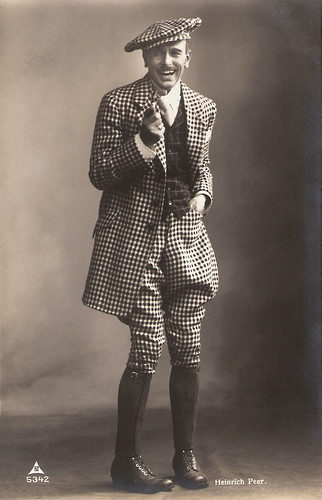
German postcard by Pm. no. 5342.
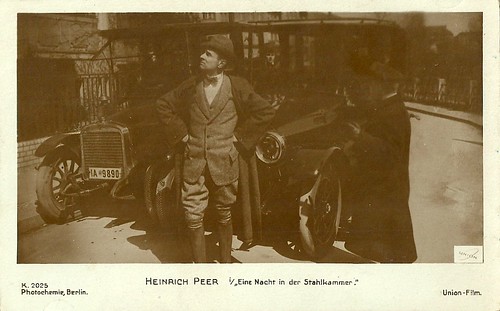
German postcard by Photochemie, Berlin, no. K.2025. Photo: Union Film. Heinrich Peer in the German silent film Eine Nacht in der Stahlkammer/A night in the tack room (Felix Basch, 1917).
During the early 1920s, Heinrich Peer was often cast opposite Lya Mara by director Friedrich a.k.a. Frederic Zelnik, such as in the Tolstoi adaptation Anna Karenina (1920), and in Die Tochter Napoleons/Napoleon’s Daughter (1922).
Peer had supporting roles in such German silent films as the comedy Die Geliebte des Grafen Varenne/Count Varenne's Lover (Friedrich Zelnik, 1921) again opposite Lya Mara, Graf Festenberg/Count Festenberg (Urban Gad, Friedrich Zelnik, 1922) starring Charles Willy Kayser, and the drama Der Evangelimann/The Evangelist (Holger-Madsen, 1924) starring Paul Hartmann.
In 1925, Heinrich Peer had another supporting part in the silent historical film Bismarck (Ernst Wendt, 1925). It portrays the life of the nineteenth century German Chancellor Otto Von Bismarck (Franz Ludwig) and was part of a popular trend of Prussian films released in Germany after the First World War.
Bismarck was followed by a second film, Bismarck 1862-1898 (Kurt Blachy, 1927), also starring Ludwig and with Peer again as an Austrian diplomat. In between, Peer appeared in another Prussian film, Die Mühle von Sanssouci/The Mill at Sanssouci (Siegfried Philippi, Frederic Zelnik, 1926) about an episode in the life of the Prussian king Friedrich II (Otto Gebühr), the construction in the 18th Century of the historic mill of Sanssouci. Peer played the king’s chamberlain.
In 1927, Heinrich Peer suddenly died in Vienna, Austria. He was 59. Peer was married to actress Bella Friese. Thomas Staedeli at Cyranos: “his career was ended premature, a career which would have certainly continued in a great way in the 30's.”
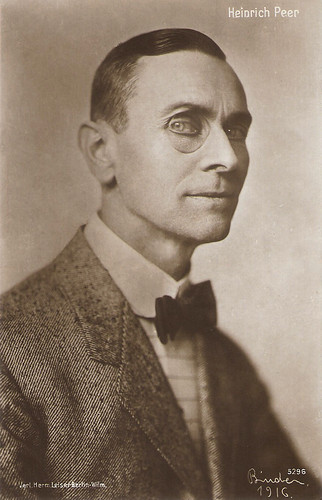
German postcard by Verlag Hermann Leiser, Berlin. no. 5296. Photo: Alex Binder, Berlin, 1916.

German postcard by Photochemie, Berlin. no. K. 115. Photo: Alex Binder, Berlin.
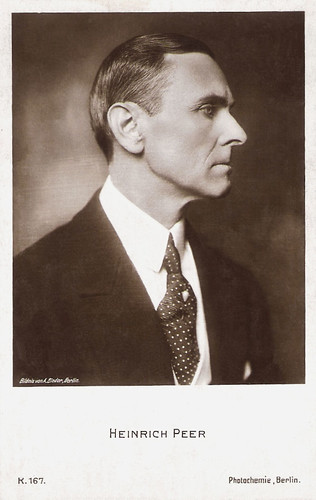
German postcard by Photochemie, Berlin, no. K. 167. Photo: Alex Binder.

German postcard by Ross-Verlag, Berlin, no. 46/5. Photo: publicity still for Bismarck, 1. Teil/Bismarck (Ernst Wendt, 1925) with Franz Ludwig as Otto von Bismarck and Heinrich Peer as Count Thun-Hohenstein. Caption: The first visit of Buismarck at the ppresident of the Bundestag, Count Thun-Hohenstein.
Sources: Thomas Staedeli (Cyranos), Stephanie D’heil (Steffi-Line – German), Filmportal,de, Wikipedia (English and German) and IMDb.

German postcard by NPG. no. K 116. Photo: Alex Binder, Berlin.

German postcard by NPG. no. 547. Photo: Alex Binder, Berlin.
The famous sleuth Harry Reep
Heinrich Friedrich Peer was born in Vienna, Austro-Hungarian Empire, in 1867. He began his stage career at the Raimundtheater in Vienna and from 1892 on, he played in a theatre in Esseg (now Osijek, Croatia). After stopovers in Innsbruck and Pressburg (now Bratislava, Slovakia), he made his Berlin debut in 1902 at the Intimen Theater.
Heinrich Peer often appeared in operettas, especially at the Theater des Westens. There he played leading roles in Oscar Straus' Ein Walzertraum (A Waltz Dream) and Franz Lehár’s Die lustige Witwe (The Merry Widow).
Already in 1911, he made his film debut. That year he played in the short silent melodrama Nachtfalter/Moth (Urban Gad, 1911), which was only the second German film with Danish diva Asta Nielsen. The shooting took place in Bioscope-Atelier Chausseestrasse in Berlin, a studio with glass walls and artificial lighting with electric light. The silent film is now considered lost, like many other films of this period.
Peer also played in the silent short Mutters Todestag/Mother’s death (Adolf Gärtner, 1911) for the Messter studio. Peer then appeared for the Vitascope studio in the very popular detective comedy Wo ist Coletti?/Where is Coletti? (Max Mack, 1913), featuring Hans Junkermann, and in the comedy Die blaue Maus/The Blue Mouse (Max Mack, 1913), featuring Fritzi Lustig.
Peer also played a count in Der Geheimsekretär/The private secretary (Joe May, 1915), a part in another popular crime series about detective Joe Deeb played by Max Landa. He next played the best friend of the title figure in the comedy Hampels Abenteuer/Hampel's Adventure (Richard Oswald, 1915) with Georg Baselt as Hampel and a supporting part in Schlemihl (Richard Oswald, 1915) starring Rudolph Schildkraut and his son Joseph Schildkraut.
Peer also appeared in dramas such as Die Ruf der Liebe/The call of love (Rudolf Biebrach, 1916) with Henny Porten, and Die Liebe der Hetty Raymond/The love of Hetty Raymond (Joe May, 1917), featuring Mia May.
In the late 1910s, Peer now and then played leading roles, such as in Im stillen Ozean/In the Silent Ocean (Danny Kaden, 1917). He played the famous sleuth Harry Reep in Eine Nacht in der Stahlkammer/A night at the vault (Felix Basch, 1917) with Harry Liedtke as a shameless bank director, and Leopoldine Konstantin as his accomplice.
In 1918, he played an English officer in Ernst Lubitsch´s silent drama Carmen (Ernst Lubitsch, 1918), which established the stardom of actress Pola Negri. Carmen was based on the novella by Prosper Mérimée. Peer played another detective, Council Anheim, in a fairly short-lived detective series, including Der grüne Vampyr/The green Vampire (William Kahn, 1918). This crime film with horror elements was one of the first films that brought vampirism on the screen.

German postcard by Verlag Louis Blumenthal, Berlin, no. 6003. Caption: `Janz feudal! Heinrich Peer als Leutnant von Grumow in Der fidele Bauer.` Der fidele Bauer (The Merry Farmer) is a 1907 German-language operetta composed by Leo Fall with a libretto by Viktor Léon. It premiered at the Mannheim Hoftheater on 27 July 1907 and was Fall's first major hit.

German postcard by Pm. no. 5342.

German postcard by Photochemie, Berlin, no. K.2025. Photo: Union Film. Heinrich Peer in the German silent film Eine Nacht in der Stahlkammer/A night in the tack room (Felix Basch, 1917).
Premature end
During the early 1920s, Heinrich Peer was often cast opposite Lya Mara by director Friedrich a.k.a. Frederic Zelnik, such as in the Tolstoi adaptation Anna Karenina (1920), and in Die Tochter Napoleons/Napoleon’s Daughter (1922).
Peer had supporting roles in such German silent films as the comedy Die Geliebte des Grafen Varenne/Count Varenne's Lover (Friedrich Zelnik, 1921) again opposite Lya Mara, Graf Festenberg/Count Festenberg (Urban Gad, Friedrich Zelnik, 1922) starring Charles Willy Kayser, and the drama Der Evangelimann/The Evangelist (Holger-Madsen, 1924) starring Paul Hartmann.
In 1925, Heinrich Peer had another supporting part in the silent historical film Bismarck (Ernst Wendt, 1925). It portrays the life of the nineteenth century German Chancellor Otto Von Bismarck (Franz Ludwig) and was part of a popular trend of Prussian films released in Germany after the First World War.
Bismarck was followed by a second film, Bismarck 1862-1898 (Kurt Blachy, 1927), also starring Ludwig and with Peer again as an Austrian diplomat. In between, Peer appeared in another Prussian film, Die Mühle von Sanssouci/The Mill at Sanssouci (Siegfried Philippi, Frederic Zelnik, 1926) about an episode in the life of the Prussian king Friedrich II (Otto Gebühr), the construction in the 18th Century of the historic mill of Sanssouci. Peer played the king’s chamberlain.
In 1927, Heinrich Peer suddenly died in Vienna, Austria. He was 59. Peer was married to actress Bella Friese. Thomas Staedeli at Cyranos: “his career was ended premature, a career which would have certainly continued in a great way in the 30's.”

German postcard by Verlag Hermann Leiser, Berlin. no. 5296. Photo: Alex Binder, Berlin, 1916.

German postcard by Photochemie, Berlin. no. K. 115. Photo: Alex Binder, Berlin.

German postcard by Photochemie, Berlin, no. K. 167. Photo: Alex Binder.

German postcard by Ross-Verlag, Berlin, no. 46/5. Photo: publicity still for Bismarck, 1. Teil/Bismarck (Ernst Wendt, 1925) with Franz Ludwig as Otto von Bismarck and Heinrich Peer as Count Thun-Hohenstein. Caption: The first visit of Buismarck at the ppresident of the Bundestag, Count Thun-Hohenstein.
Sources: Thomas Staedeli (Cyranos), Stephanie D’heil (Steffi-Line – German), Filmportal,de, Wikipedia (English and German) and IMDb.
No comments:
Post a Comment